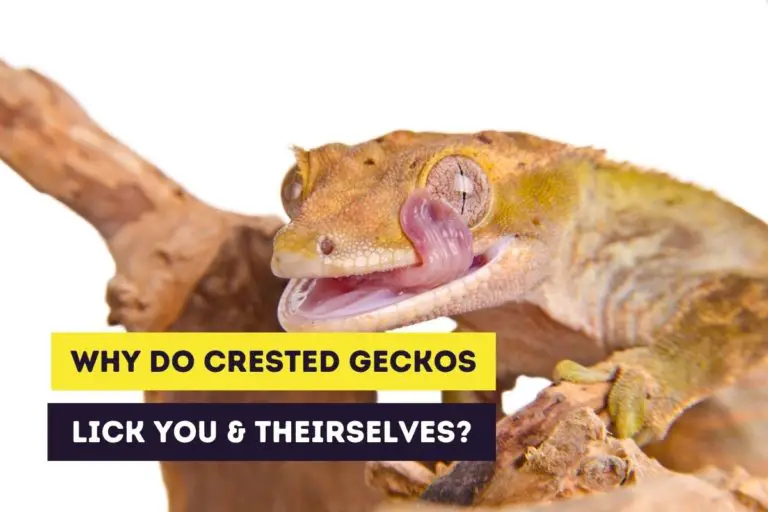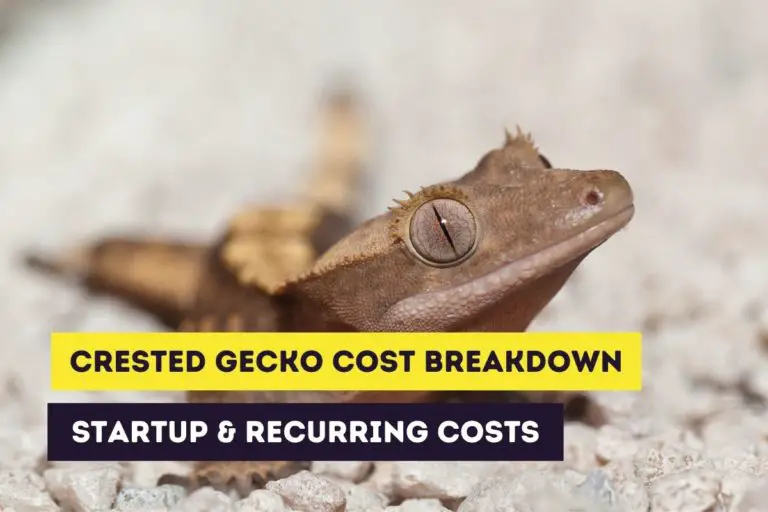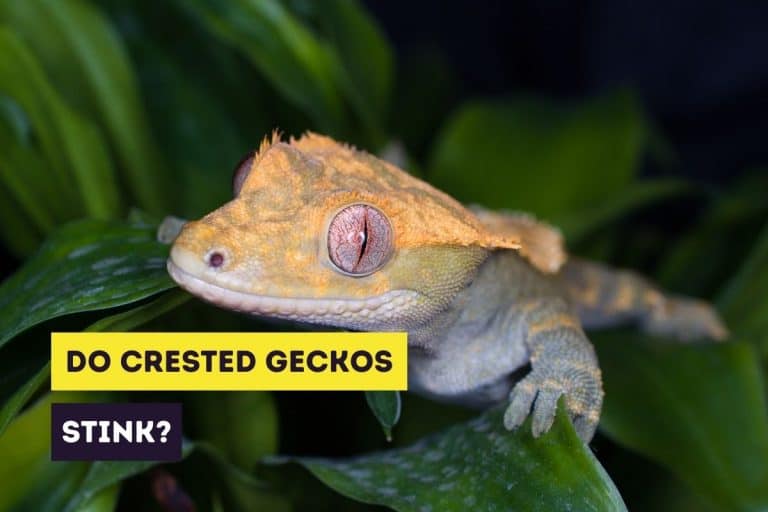Why Is My Crested Gecko on the Ground? (Reasons & Solutions)
Crested geckos are arboreal animals that mostly live above the ground. But there might be several reasons for your crested gecko to get on the floor of a terrarium. So why can a crested gecko sometimes stay on the ground?
Crested geckos stay on the ground for multiple reasons. There might not be enough foliage in the enclosure or the humidity can be too low. Your crested gecko might also be gravid or in the process of shedding. Lastly, the temperature might be too high, which encourages your crested gecko to burrow.
You shouldn’t always worry when your crested gecko is on the ground of the enclosure. It’s not uncommon for a crested gecko to stay on the ground and it can even be considered normal behavior that all crested geckos exhibit.
But you should look for the reasons why your crested gecko is on the ground, especially when it spends more time on the ground than above it.
If you’re interested in stickers or other products of crested geckos, you can always visit our Etsy Shop, which is called Artful Animalia. We currently only send stickers in the United States. If you’re interested in certain crested gecko-related products, don’t hesitate to contact us.
If you notice that your crested gecko is lethargic both day and night, you should seek a vet’s advice. Your crested gecko may have an injury that makes it painful to climb and jump. Or there may be an illness, so your crested gecko doesn’t feel well.
In this article, you’ll learn in-depth about the reasons for a crested gecko to stay on the ground. You’ll learn what you can do to make sure that your crested gecko, as an arboreal species, shows natural behavior.
This site contains affiliate links to products we recommend and use ourselves. We may receive a commission for purchases that you make through these links. If you’re interested in learning more about our affiliate links, please visit our (affiliate) disclaimer.
Reasons a Crested Gecko Stays on the Ground
Crested geckos are gentle creatures that aren’t very active during the day. Staying near or on the ground during the day is expected behavior if there are hides or foliage where your crested gecko can sleep.
But during the night, it’s normal for a crested gecko to become more active and jump and climb. Many new crested gecko owners struggle with crested gecko’s nocturnal behavior because it can make it difficult to watch their gecko’s action during the night (while we’re sleeping).
You often don’t see them eating or jumping because they’re active while you were asleep. You can remedy this by placing a night vision camera (with an SD-cart) near the enclosure. This is useful, especially for making sure that your crested gecko is eating! I would highly recommend the Wyze Cam with Night Vision.
Stress
Crested geckos can be stressed for several reasons, which I won’t get into in this article. But it’s important to know that a stressed crested gecko will want to stay in a hide or under foliage to feel safe and protected.
It’s possible that it feels safer on the enclosure floor, where it can be more difficult to be seen.
Lack of foliage
A crested gecko loves to jump and climb in its enclosure. But to do so, you have to make sure that your crested gecko can jump and stay above the ground.
An enclosure without plants, vines, and branches makes it very difficult – if not impossible – for your crested gecko to jump and climb. Your crested gecko might climb on the glass sides, but it won’t stay there all day. In an enclosure without enough foliage, your crested gecko might remain on the ground.
Low humidity
Crested geckos need an average humidity between 70 and 80 percent. The humidity in the enclosure shouldn’t always 80 percent. It’s recommended to let the humidity level drop gradually until it reaches about 50 percent.
When the humidity in the enclosure isn’t high enough, your crested gecko might seek moisture on the ground. The substrate absorbs water and your crested gecko will stay on the substrate to absorb some of this moisture.
Shedding process
A crested gecko will go through the process of shedding its entire life. Baby and juvenile crested geckos will shed more often than adult crested geckos.
It”s possible that your crested gecko is on the ground when it’s shedding. This is because crested geckos are less active while shedding and looking for more humidity to help.
A crested gecko that’s sometimes shedding also is less “sticky”, which means that it’s toepads don’t adhere to the glass as easily (making it more difficult to climb).
High temperature
Crested geckos need a temperature between 72 and 78 degrees Fahrenheit, although they can tolerate slightly lower and higher temperatures for short periods.
When the temperature is too high, your crested gecko will try to cool down by staying in a hide or staying near the ground and burrowing in the substrate. When you notice this behavior, make sure to check the temperature in the enclosure and cool it down if needed.
Gravid crested gecko
A gravid crested gecko will spend more time on the ground of the enclosure, especially when it’s near the time of egg-laying. She will be looking for a place to lay her eggs and burrow them in the substrate.
Other telltale signs of a gravid crested gecko are that her belly will be round, and she will gain weight. A gravid crested gecko will also eat less to nothing near the end of the pregnancy.
A little side note, a female crested gecko can also lay eggs while she hasn’t mated. The eggs will be infertile, but there will still be eggs.
Problems with climbing
When your crested gecko stays on the ground, it can also be caused by problems with climbing. Problems with climbing can be caused by problems with:
- shedding
- humidity
It can also be caused by a dirty enclosure or by dirt on the feet of your crested gecko. Make sure to keep your enclosure clean and to remove dirt from the feet when you notice it!
Lastly, it’s also possible that your crested gecko is injured (internally or externally) or is ill. An injury can cause your crested gecko to stay on the ground because it can’t climb without pain.
Possible Solutions
Preventing stress
Although it’s not always possible to prevent your crested gecko from becoming stressed, it’s important to try to avoid it as much as possible.
When you first get your crested gecko, don’t handle it the very first few days. Let it explore its enclosure on its own and find hiding places in it.
As you and your crested gecko get used to the presence of each other, you can start to handle it but don’t chase it through the enclosure. This can cause a lot of stress for such a little creature.
Enough foliage and hiding places
Ensure that there is enough foliage in the enclosure and that there are enough places in the enclosure where your crested gecko can hide when it wants to sleep or becomes stressed.
As a rule of thumb, the enclosure should be 50 percent filled with plants. Your crested gecko still needs to be able to jump and climb around the enclosure.
Right temperature and humidity
As I already mentioned, crested geckos need a temperature between 72 and 78 degrees Fahrenheit and a humidity between 70 and 80 percent.
Slight variations in temperature and humidity won’t cause a problem. It’s even recommended to let the humidity go down until 50 percent before you mist again to prevent bacterial and fungal growth.
Ensure that your crested gecko always has the right temperature and humidity. You can use a digital thermometer and hygrometer for this purpose. As I already mentioned, a crested gecko that stays on the ground might seek moisture or try to cool down (or both).
When the temperature is too high, make sure to cool down the room and the enclosure. But don’t put the enclosure in the vicinity of an air conditioning or ventilation system.
When the humidity is too low, you should mist more often and use a suitable substrate (for example, spaghnum moss) to help maintain a humid terrarium.
Keeping an eye on your crested gecko
Low humidity can cause shedding problems. Climbing problems, on the other hand, can be caused by dirty feet but can also be the sign of an injury.
Keep an eye on your crested gecko and watch for any abnormal behavior (most common is lethargy and not eating) and ensure that there’s no stuck shed skin.
If you see a shedding problem, you should try a shedding box or moisture hide. You can make it yourself or buy one. These boxes provide higher humidity in a small place to promote shedding.
If you notice lethargy (even during the night), you should seek the advice of a vet. If you see an injury, I would always recommend getting help from a vet.
Regular cleaning of the enclosure
A dirty enclosure is a less common cause for a crested gecko to stay on the ground. But it’s possible that the enclosure’s glass is dirty and that your crested gecko can’t climb on it. It’s also possible that your crested gecko got dirt on its feet or tail and can’t get it off.
Make sure to clean the enclosure regularly. This means that you should spot-clean daily and give the enclosure a thorough cleaning once a month.
Also, check the feet and tail of your crested gecko for any stuck dirt that makes it difficult to climb. If there’s dirt on it, you can try to remove it gently by giving it a sauna (damp paper towel in a container) and using a q-tip to remove the dirt.
Want to Learn More
If you want to learn more about crested geckos as pets, please read the following articles.
If you’re interested in getting crested geckos as pets you should also definitely read our article about baby and juvenile crested gecko care or (adult) crested gecko care.







